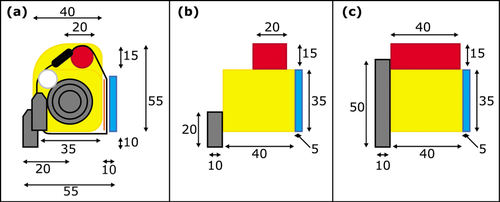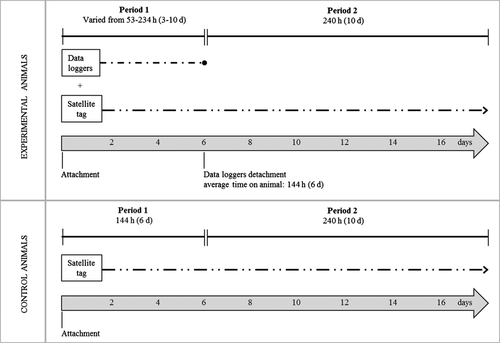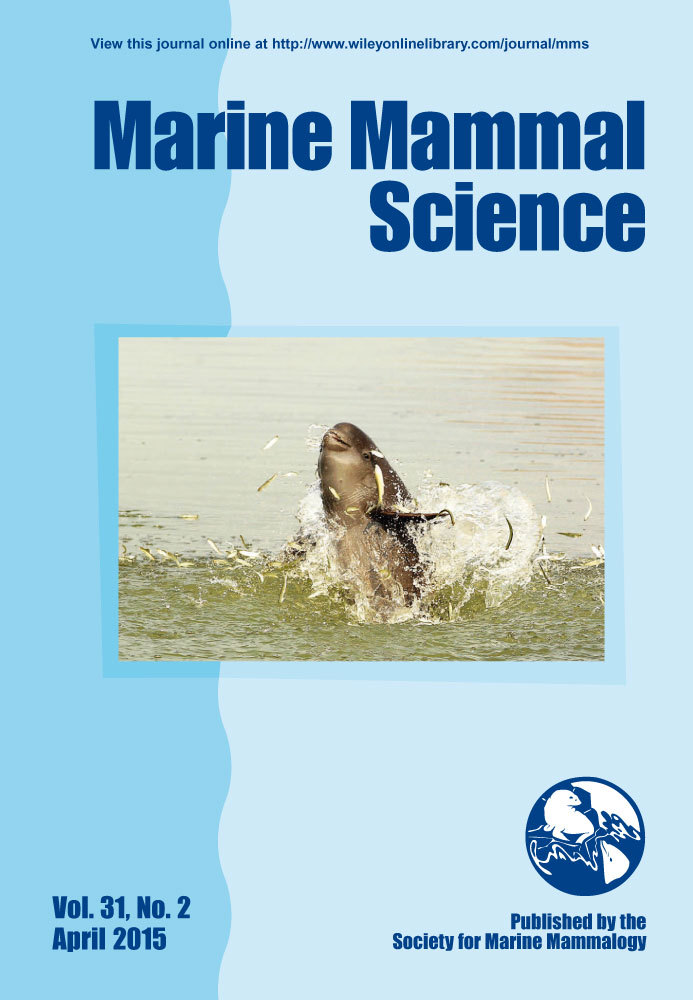Do larger tag packages alter diving behavior in harbor porpoises?
Studying behavior of wild cetaceans relies heavily on the development and use of electronic tagging devices. Several methods are available for attaching tags to cetaceans including: shooting or pushing them, or anchoring them, into the tissue of large whales (e.g., Heide-Jørgensen et al. 2001); suction cups (e.g., Johnson et al. 2009); or one or more pins through the dorsal fin of small cetaceans (e.g., Read and Westgate 1997, Scott and Chivers 2009).
Despite their increasingly widespread use, only limited information is available on the effects of such attachments on the diving behavior of the animals. Elucidation of these effects is important for assessment of the reliability of the tag data, as well as for animal welfare considerations. Such studies of the impacts of research are commonplace in other disciplines (e.g., Hansen et al. 2011, Evans et al. 2012) and provide reassurance to managers and scientists that the methodology involved is not unduly influencing the quality of the results obtained. Some efforts have been made to quantify the impacts of tags on some species (see Wilson and McMahon 2006), however, the very nature of the research often provides data that cannot be obtained through other methods, especially in cetaceans that never come to land. Accordingly, assessing changes in behavior at depth resulting from any attached package is inherently difficult.
Despite this, a few studies have made efforts to assess the effects of tags or tagging on the behavior of cetaceans. One was limited in its application as it was based on a single captive animal and the short-term observed changes may have been related to the tranquilizers (Valium) used instead of the tagging (Geertsen et al. 2004). Two studies have documented physiological stress responses with high levels of individual variation following handling and tagging (Eskesen et al. 2009, St. Aubin et al. 2013). Other studies found that more streamlined tags have fewer potential problems associated with drag causing tag migration and compromised tissue healing (Sonne et al. 2012, Balmer et al. 2014).
In this study, we had an opportunity to investigate possible impacts resulting from two combined package sizes as part of a broader Danish tagging study using Argos satellite tags on harbor porpoises (Phocoena phocoena) (Teilmann et al. 2007). Between 1997 and 2011, 92 harbor porpoises—incidentally trapped in pound nets set by local fishermen—were equipped with various versions of Argos satellite tags along the Danish coast of the Kattegat and the Belt seas (see Teilmann et al. 2007, 2013; Edrén et al. 2010; Sveegaard et al. 2011; Sonne et al. 2012). These tags collect data on movements, diving behavior and locations of the porpoises, and transmit the information via the Argos system, meaning there is no need to recover the tag. More recently, a series of secondary deployments have also been made to collect additional information on the behavior of the animals. These are clipped to the back plate of the Argos tag on the other side of the fin and are released after a set period to allow for recovery (see Linnenschmidt et al. 2012, Wright 2013).
Consequently, the broader study required the occasional use of double tagging (a satellite tag and a secondary data logging tag that provided dive data) on some animals for part of the period at the beginning of the deployment, while other animals had a single tag for the entire deployment period. This set up an ideal design for testing the effect of the second tag on the behavior of the porpoises. Thus, in this study, we aim to assess whether short-term attachment of the secondary data logger unit in combination with the satellite tag, resulting in a larger overall instrument package, alters the diving behavior of wild harbor porpoises. To achieve this, we compared transmitted behavioral data from the period with the secondary data logger unit (in addition to a satellite tag) with the period following release of the secondary tag unit, as well as with animals only equipped with a satellite tag.
Specifically in this study, we consider 12 porpoises, incidentally trapped in pound nets between March 2009 and September 2011 (Table S1, Fig. S1), and equipped with identical Argos satellite-linked-dive-recorder transmitters (SPLASH; Wildlife Computers, Redmond, WA) using three pin attachment through the dorsal fin (see Teilmann et al. 2007 for details on the attachment methodology). Depths around the tagging sites were generally less than 50 m, although some of the porpoises visited deeper waters (down to 700 m) of northeastern Kattegat, Skagerrak, and the North Sea during their deployments. Five porpoises were tagged with only the satellite tag and will hereafter be referred to as “control animals.” Seven of these porpoises were also outfitted with the above-mentioned secondary package, which detached from the animal after an average of 6 d, leaving only the Argos tag remaining. These secondary packages were hand-built units consisting of several data loggers mounted together and housed in high-density closed-cell foam for buoyancy and thus recovery, had a weight of approximately 230 g in air and were slightly positively buoyant in water. Although the majority of the frontal area was angled, it can be approximated that the units had a flat frontal surface area of between 19 cm2 and 25 cm2 (see Fig. 1). This represents the additional surface area over which drag may be increased for the animal during the deployment of the second unit and the direct focus of the comparisons detailed here. The seven animals equipped with both a satellite tag and a secondary tag unit will henceforth be referred to as “experimental animals.”

The Argos tags transmitted various aspects of diving behavior in the form of frequency histograms sorted into bins summarized over a 6 h period. For this study, we used the time spent at various depth intervals (TAD) and dive duration within 14 user-defined intervals. For TAD these were 0–0 m (tag above water = surface time), 0–2 m, >2–5 m, >5–10 m, >10–15 m, >15–20 m, >20–25 m, >25–30 m, >30–40 m, >40–50 m, >50–60 m, >60–70 m, >70–80 m, and >80 m. For dive duration, the 14 intervals were 0–30 s, >30–60 s, >60–90 s, >90–120 s, >120–180 s, >180–240 s, >240–300 s, >300–360 s, >360–420 s, >420–480 s, >480–540 s, >540–600 s, >600–1,200 s and >1,200 s. Surface time is also transmitted as the hourly percentage of time where the tag is above water per day.
The dive data were divided into the time period before and after detachment of the secondary data logger unit. The first bin (corresponding to a 6 h time period for TAD and dive duration, and a 1 h time period for surface time) during the tag attachment handling was excluded from the analysis as this bin included data prior to tagging. The time bin that included the detachment of the second tag unit was also removed as it contained a mix of dive data collected during two different periods of the experiment (i.e., double tag and single tag periods). For experimental animals, “Period 1” was determined as the time (in hours) with both the satellite tag and the second tag unit attached to the porpoise. This period varied from 53 to 234 h (approximately 3–10 d), depending upon the desired deployment length and in some cases the premature release of the cable tie. The control animals were only equipped with the satellite tag attached during the entire period. Nonetheless, we refer to the first 144 h (6 d) as “Period 1” for the control animals, equaling the average time that the experimental animals carried both tags. “Period 2” was defined as 240 h (10 d) following either detachment of the secondary data logger unit for the experimental animals or following the end of the first 6 d for the control animals (see Fig. 2).

Data from the satellite transmitters were obtained by the Argos Location Service Plus satellite system. The software program WC-DAP 3.0 (Wildlife Computers) was used to validate the dive data (TAD, dive duration and timelines) received from Argos and transform them into an ASCII format. In two cases the transmitted data reported hourly surface time proportions that were greater than 100%. Fortunately, the suspect data was from periods when the animals were also carrying the secondary data logger unit, allowing the information to be verified using the loggers incorporated there (see Wright 2013 for details of analysis of the data from the secondary data logger unit). The data were found to be unrepresentative and the entire 24 h summaries that incorporated the corrupted data and therefore discarded. Specifically, these were the first day for porpoise 201106421 and the third day for porpoise 201156570.
Linear mixed effect models using maximum likelihood were used to analyze the effects of the secondary tag in terms of depth (calculated from the proportion of time spent at the mean depth value for each bin), dive duration and surface time. Mean values of depth and dive duration were calculated for each 6 h bin and used as dependent variables, while the mean of the hourly reported time spent at the surface was calculated across 6 h blocks and used as a dependent variable in the analysis of surface time. The models were constructed with individual as random factor, while time of day (0–6 a.m., 6–12 a.m., 12–6 p.m., and 6–12 p.m.), period (Period 1 and 2) and the presence or absence of the second tag during Period 1 were fixed factors. Depth and surface time data were log-transformed to reduce skewness and approximate normal distribution. Statistical analyses were performed using R statistical software (version 3.0.0, R Development Core Team 2013) with the package nmle (Pinheiro et al. 2014).
Experimental animals were observed to spend time at depths of >80 m in both periods, while control animals only reached depths of >50–60 m during Period 1 and >40–50 m in Period 2. Despite this, the modeled effect of the secondary tag was a reduction of mean depth position in the water column (the mean of the histogram data) to 61% (SE = 14.8%). The mean depth value for all the data points was 7.6 m. The secondary tag was the only modeled factor to have a significant effect on dive depth (Table 1).
| Source | Effect | SE | df | F | P > F |
|---|---|---|---|---|---|
| Dive depth | |||||
| Intercept | 854.9% | 17.3 | 1 | 250.25 | <0.0001 |
| Time of day | 15.0% | 10.8 | 3 | 0.63 | 0.6 |
| Period | 22.4% | 11.4 | 1 | 0.04 | 0.85 |
| Secondary tag | −39.3% | 14.8 | 1 | 11.02 | 0.001 |
| Dive duration | |||||
| Intercept | 84.5 s | 5.6 | 1 | 286.14 | <0.0001 |
| Time of day | −9.3 s | 3.2 | 3 | 4.79 | 0.003 |
| Period | −3.5 s | 3.2 | 1 | 0.17 | 0.68 |
| Secondary tag | −5.6 s | 4.8 | 1 | 1.37 | 0.24 |
| Surface time | |||||
| Intercept | 4,540.1% | 13.4 | 1 | 1,035.34 | <0.0001 |
| Time of day | 23.0% | 6 | 3 | 6.81 | 0 |
| Period | 23.5% | 11.4 | 1 | 16.03 | 0 |
| Secondary tag | 2.8% | 10.4 | 1 | 0.07 | 0.79 |
The mean dive duration of all porpoises ranged between 54 s and 128 s. The modeled effect of the secondary tag on dive duration was a reduction of 5.6 s (SE = 4.8 s) of the mean duration. The only factor to have a significant effect on dive duration was time of day. The greatest difference found here was 9.3 s (SE = 3.2 s) shorter dive duration in Block 4 (6–12 p.m.) compared to Block 1 (0–6 a.m.).
The overall mean time spent at the surface across all animals and periods was 18.9 min/h. The modeled effect of the secondary tag on surface time was an increase in time spent at the surface of 3% (SE = 10%). This effect was not statistically significant. The time of day and period relative to tagging (Period 1 or 2) did have significant effects on surface time (Table 1). The largest diel difference was between Block 2 (6–12 a.m.) and Block 4 (6–12 p.m.), where animals were predicted to spend 23% (SE = 4.8%) less time at the surface in Block 2. Animals were predicted to spend 24% (SE = 11.4%) more time at the surface in Period 2 than in Period 1.
Attaching data loggers and satellite tags to small cetaceans for more than a few hours currently requires attachment with pins through the dorsal fin. The increase in hydrodynamic drag may have an impact on the diving behavior of the animal. Since it is almost impossible to study details of the diving behavior of cetaceans in the wild without the use of electronic devices, it is also impossible to study and test the effect of a tag through comparison with wild animals that are not tagged. In this study, we therefore looked at the difference in behavior between porpoises initially carrying two tags, then subsequently only a single tag and then compare the behavior of these animals with control animals. While previous studies have shown limited detectable effect on porpoise stress responses during tagging (Eskesen et al. 2009) and behavior in captivity (Geertsen et al. 2004), this study is the first to investigate the effects of any tag (albeit secondary) on diving behavior of free-ranging cetaceans.
The estimated effects of the secondary tag on time spent at the surface and dive duration were modest and not statistically significant. However, our model estimated a substantial effect on the average depth position of the porpoises, which was predicted to be 61% of the depth without the secondary tag. The decreased time spent at greater depths could result from increased drag or buoyancy from the two tags compared to only one tag. Perhaps most importantly, we note that these differences would not have been detected from a visual study of surfacing behavior, thus confirming the necessity of tagging studies in the study of cetacean behavior.
It should be acknowledged that the small sample size and the large variation among animals may have obscured subtle effects on the behavior. Furthermore, it is quite possible that any additional effects of the secondary tag unit may be small in comparison to those of the first tag, which cannot be assessed with this data set. The result may also be influenced by the depths of the areas that were visited during the first days by these animals. However, any behavioral constraints imposed by the areas used (e.g., shallow areas) could not be assessed due to the combination of the limited number of Argos locations (only a few hours transmission to save battery) and the format of the dive data transmitted by the Argos units (6 h bins). Finally, it is also entirely possible that any relatively small changes in behavior may be obscured by untested factors, such as sex, age, etc. However, full analysis of these factors was not possible due to the small size of the data set.
It is important to assess to what extent the observed differences (or any other differences that may not have been detected due to their small size) may affect the animals over the long-term. While this could not be determined from this data set, Sonne et al. (2012) studied the physical effect of two different satellite tags on two harbor porpoises that were subsequently lethally bycaught. Both porpoises were found in good conditions and had full stomachs 3–12 mo after tagging. However, Sonne et al. (2012) also showed that earlier tag designs may have greater impact on the fin, probably relating to the larger drag, while more advanced, hydrodynamic designs facilitate healing of the pin holes and longevity of tags for up to more than a year.
It is worth considering the noise from the automatic release mechanism of the secondary data logger unit. This small explosion produces a broadband sound, with energy mostly below 1 kHz, but reaching beyond 50 kHz. At the approximate position of exposure, this has a 90% SEL of around 178–181 dB re: 1μPa2 (although this includes a sizable reflection from the testing pool) over 28 ms (JT, unpublished data). It is possible that this could potentially influence the animal's behavior for a brief period immediately after detachment of the data logger. However, in this study, we did not detect any effect of exposure to this sound in the diving data recorded by the satellite transmitter.
Despite the potential impacts, the use of secondary data logger units in combination with satellite transmitters can provide a detailed description of diving and biosonar behavior. As such, the tagging of small cetaceans with this combination of tags provides unparalleled temporal and spatial information on areas used for foraging and socializing and can thus be a valuable tool in the management and protection of the species, e.g., by identifying potential conflict areas with fisheries.
Acknowledgments
We wish to thank the pound net fishermen and the people who volunteered to join during fieldwork for their invaluable contribution to the tagging project. Tim Gerrodette is thanked for his advice regarding the statistical analyses. We are also grateful to Len Thomas and Leslie New for input on earlier versions of the manuscript. Thanks are also due to Jakob Tougaard for assistance with the acoustic analysis of the explosive releasers. The study was carried out with permission from Danish Forest and Nature Agency, Ministry of Environment (SN 343/SN-0008) and the Animal Welfare Division (Ministry of Justice, 1995-101-62). The Danish Forest and Nature Agency and the EU LIFE+ project SAMBAH (LIFE08 NAT/S/000261) funded the study.




